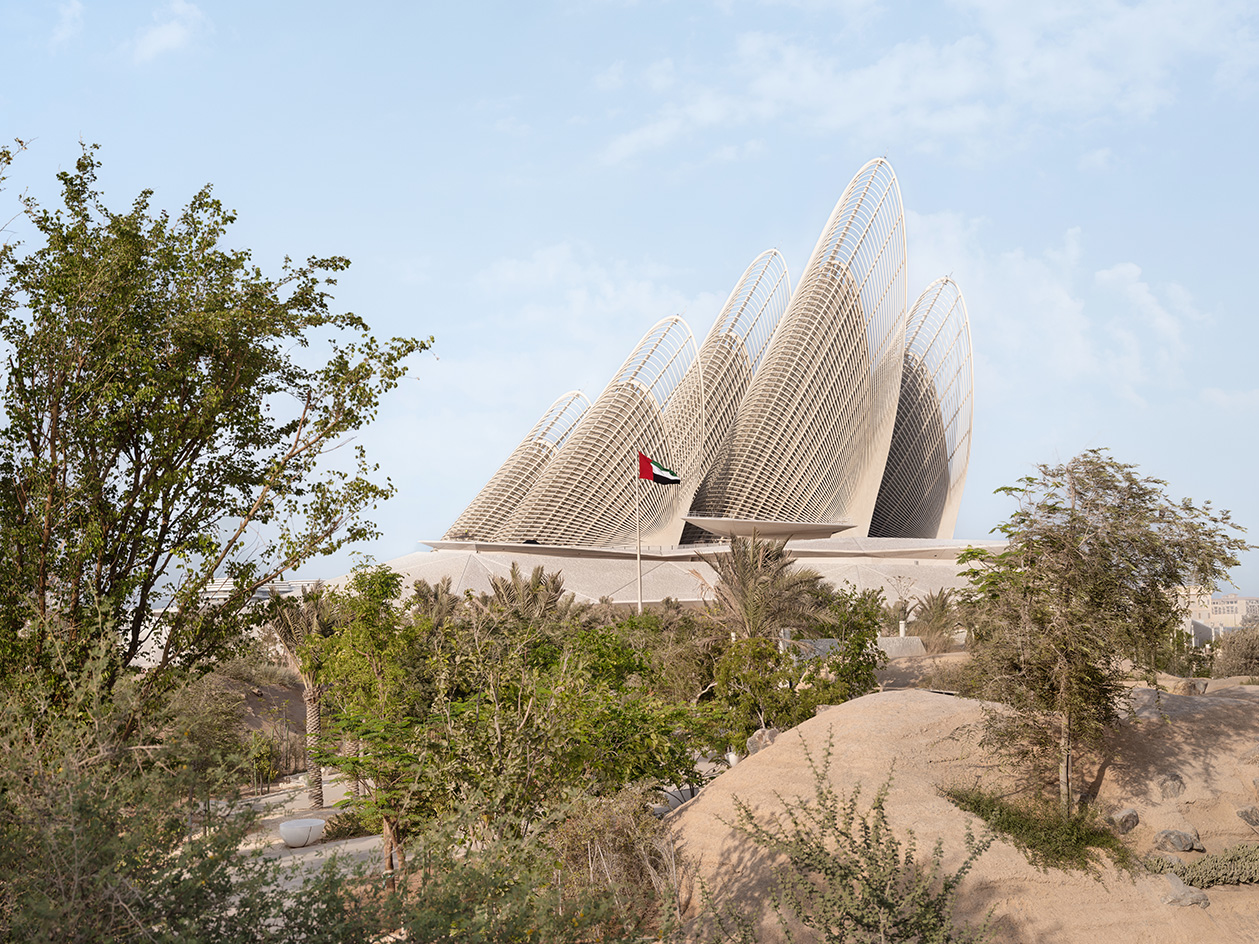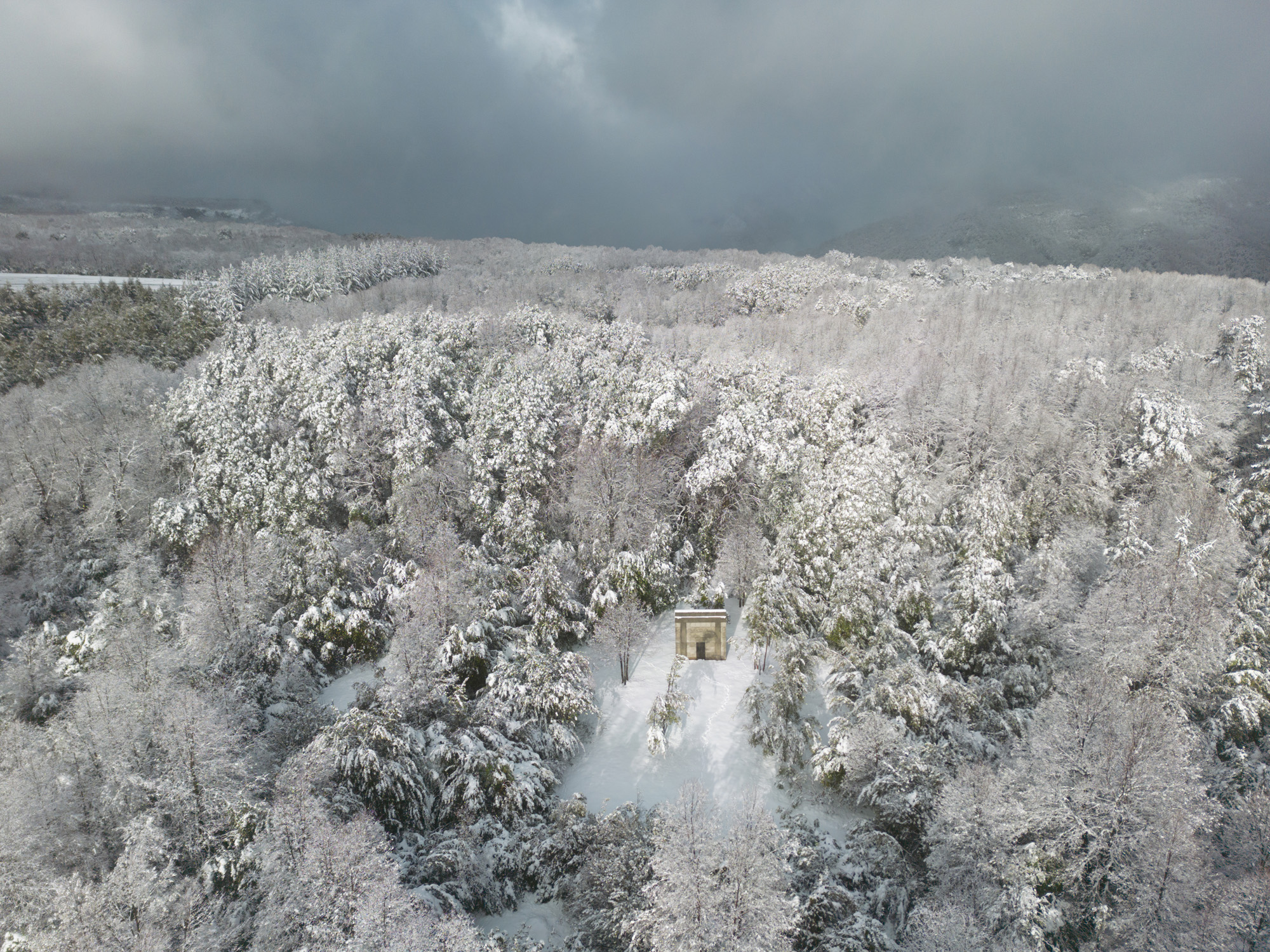Art Jameel pavilion in Dubai is a dome to fight climate doom
Art Jameel pavilion by Lebanese practice theOtherDada flags sustainability in Dubai, and opened to coincide with COP 28

This new Art Jameel pavilion, Tarabot: Weaving a Living Forum, commissioned by the arts organisation and designed by Lebanese practice theOtherDada, is a fractal, domed structure stretching over the amphitheatre at the Jaddaf Waterfront Sculpture Park in Dubai. Weaving together traditional and high technologies, recycled waste materials and indigenous plants, the architectural pavilion aims to bring life to the area over the next five months, forming a new ‘interspecies habitat’.
It sees Art Jameel, which supports artists and creative communities and is behind both the sculpture park and the wider Jameel Arts Centre, promote a conversation about sustainability and re-use.
Founded in 2010 by architect Adib Dada, theOtherDada pushes the boundaries of traditional architecture, adopting a ‘holistic and biomimetic design approach with nature and people at its core’. Reflects Dada, ‘I had these two diametrically opposed practices – building for humans and building for other organisms […] When this commission came along, it became an opportunity to weave these two practices together in a meaningful way.’
Art Jameel pavilion, a study in sustainablity

Deeply involved in contemporary art scenes and climate activism in Beirut, from leading ‘Toxic Tours’ of the Beirut river to developing tree-planting project theOtherForest, Dada was invited to an Art Jameel symposium in March 2023 to discuss the role of arts institutions in addressing the climate crisis.
Art Jameel director Antonia Carver explains, ‘What does it mean to create exhibitions in this climate? What do we do with all the materials after?’ As a direct result of the symposium, Art Jameel has been rethinking its exhibition production processes and reusing waste such as gypsum moulds.
‘Tarabot is an Arabic word that means “weaving together” [...] we’re weaving together issues of architecture, urbanism, ecology, wildlife and human-life centred design,’ says Dada. A lack of shade and life on the pavilion’s site prompted a shade-providing design. Working closely with architect Dalia Hamati, Nader Akoum, scientists, and desert conservationists, Dada conceptualised four life-giving ‘pillars’ – Soil, Water, Plants and Energy – for the pavilion, corresponding to the dome’s three touchpoints with the ground, and its roof.

The first pillar, Soil, makes compost out of waste from the art centre’s exhibitions, neighbouring restaurant Teible and coffee shop. Encased in modular ‘bouquets’ made from local date palm waste, a zero-carbon material, by Desert Board, the waste is broken down by mycelium (the root-like system of fungus).
Receive our daily digest of inspiration, escapism and design stories from around the world direct to your inbox.
The Water pillar uses solar power to condense and filter water from the humidity in air. This water drips through a series of traditional passive cooling clay cones, handmade by local potters, collecting as freshwater in the pavilion pool.
The Plants pillar uses the composted soil and collected fresh water to grow vegetables that return to the restaurant. Salicornia, an indigenous edible plant able to grow in saltwater, is also planted, further attracting insects, birds and pollinators. Artwork from multidisciplinary Dubai-based artist Solimar Miller features intricate handcrafted prints on upcycled fabrics, representing indigenous flora and fauna that are endangered in the UAE.
The Energy pillar, on the roof features aluminium cones that funnel sunlight into the pavilion, and Arish, traditional palm-leaf roofing systems provide shade.

Artist Solimar Miller, featuring 24 meters of upcycled cotton fabric, hand silkscreened with branches and leaves from indigenous UAE Ghaf trees, and hand painted with representations indigenous endangered flora and fauna
Almost all materials used in the pavilion are biodegradable or fully recyclable. Once it’s dismantled, the modular cones of soil and plants will be divided and taken to garden homes and balconies by local communities, disseminating indigenous plants in the region. The unfinished steel structure’s fractal design was fine-tuned with local coral practitioners in the Emirate of Fujairah, and the structure will take on new life as an underwater habitat for coral, ‘linking life on land to life underwater’.
On what he hopes visitors will take away from the project, Dada muses, ‘I think developing a culture of care and understanding on the more than human. It’s not about us saving the planet. The planet doesn’t need saving, we need saving.’
Tarabot: Weaving a Living Forum is open to the public at Jadaf Waterfront Sculpture Park, Dubai until 30 April 2024

Architect Adib Dada
Nana Ama Owusu-Ansah is a writer and photographer from London. She first wrote for Wallpaper* in 2021, in a series on the new vanguard of African designers practising in Africa and its diaspora. She is drawn to projects centring on decolonial approaches to art, architecture, as well as community and sustainability. Nana Ama read Economics and Spanish at University of St Andrews, and, as an avid linguist, is passionate about using accessible language to invite new audiences to engage in design discourse.
-
 Usher opens up about breakfast playlists, banana pudding and why a glass tumbler is always on his rider
Usher opens up about breakfast playlists, banana pudding and why a glass tumbler is always on his riderOn the heels of a collaboration with Baccarat, the Grammy-winning singer-songwriter breaks down his entertaining tips. 'Hosting is an expression of how you feel about your guests and also who you are.'
-
 The beauty trends that will define 2026, from ultra-niche fragrances to anti-ageing dental care
The beauty trends that will define 2026, from ultra-niche fragrances to anti-ageing dental careAs we enter the new year, we speak to experts in fragrance, skincare, aesthetics, wellness and more about the trends that will be shaping the way we look
-
 The most stylish hotel debuts of 2025
The most stylish hotel debuts of 2025A Wallpaper* edit of this year’s defining hotel openings. Design-led stays to shape your next escape
-
 Zayed National Museum opens as a falcon-winged beacon in Abu Dhabi
Zayed National Museum opens as a falcon-winged beacon in Abu DhabiFoster + Partners’ Zayed National Museum opens on the UAE’s 54th anniversary, paying tribute to the country's founder and its past, present and evolving future
-
 RIBA launches new awards – and for the first winners, we look to the Middle East
RIBA launches new awards – and for the first winners, we look to the Middle EastThe RIBA Middle East Award winners are announced today. The first of the organisation's two new territory awards series honours a women-only mosque, a luxury hotel, a city park and more
-
 A Chilean pavilion cuts a small yet dramatic figure in a snowy, forested site
A Chilean pavilion cuts a small yet dramatic figure in a snowy, forested siteArchitects Pezo von Ellrichshausen are behind this compact pavilion, its geometric, concrete volume set within a forest in Chile’s Yungay region
-
 Doshi Retreat at the Vitra Campus is both a ‘first’ and a ‘last’ for the great Balkrishna Doshi
Doshi Retreat at the Vitra Campus is both a ‘first’ and a ‘last’ for the great Balkrishna DoshiDoshi Retreat opens at the Vitra campus, honouring the Indian modernist’s enduring legacy and joining the Swiss design company’s existing, fascinating collection of pavilions, displays and gardens
-
 Oystra is ZHA’s sculptural vision for living in the United Arab Emirates
Oystra is ZHA’s sculptural vision for living in the United Arab EmiratesMeet the team translating ZHA’s bold concept for the new development into ‘a community elevated by architecture’ – Dewan Architects + Engineers and developer Richmind
-
 Slides, clouds and a box of presents: it’s the Dulwich Picture Gallery’s quirky new pavilion
Slides, clouds and a box of presents: it’s the Dulwich Picture Gallery’s quirky new pavilionAt the Dulwich Picture Gallery in south London, ArtPlay Pavilion by Carmody Groarke and a rich Sculpture Garden open, fusing culture and fun for young audiences
-
 Lego and Serpentine celebrate World Play Day with a new pavilion
Lego and Serpentine celebrate World Play Day with a new pavilionLego and Serpentine have just unveiled their Play Pavilion; a colourful new structure in Kensington Gardens in London and a gesture that celebrates World Play Day (11 June)
-
 The Serpentine Pavilion 2025 is ready to visit, ‘an exhibition you can use’
The Serpentine Pavilion 2025 is ready to visit, ‘an exhibition you can use’The Serpentine Pavilion 2025 is ready for its public opening on 6 June; we toured the structure and spoke to its architect, Marina Tabassum